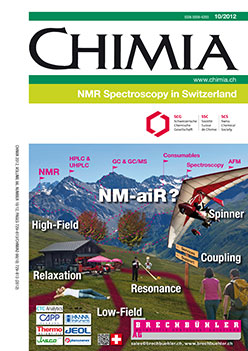NMR Spectroscopy in Bioinorganic Chemistry
DOI:
https://doi.org/10.2533/chimia.2012.791Keywords:
Bioinorganic chemistry, Nmr spectroscopyAbstract
Multinuclear and multidimensional nuclear magnetic resonance (NMR) spectroscopy is applied in our groups to gain insights into the role of metal ions for the function and structure of large biomolecules. Specifically, NMR is used i) to investigate how metal ions bind to nucleic acids and thereby control the folding and structure of RNAs, ii) to characterize how metal ions are able to stabilize modified nucleic acids to be used as potential nanowires, and iii) to characterize the formation, structure, and role of the diverse metal clusters within plant metallothioneins. In this review we summarize the various NMR experiments applied and the information obtained, demonstrating the important and fascinating part NMR spectroscopy plays in the field of bioinorganic chemistry.Downloads
Published
2012-10-31
How to Cite
[1]
D. Donghi, S. Johannsen, R. K. O. Sigel, E. Freisinger, Chimia 2012, 66, 791, DOI: 10.2533/chimia.2012.791.
Issue
Section
Scientific Articles
License
Copyright (c) 2012 Swiss Chemical Society

This work is licensed under a Creative Commons Attribution-NonCommercial 4.0 International License.







